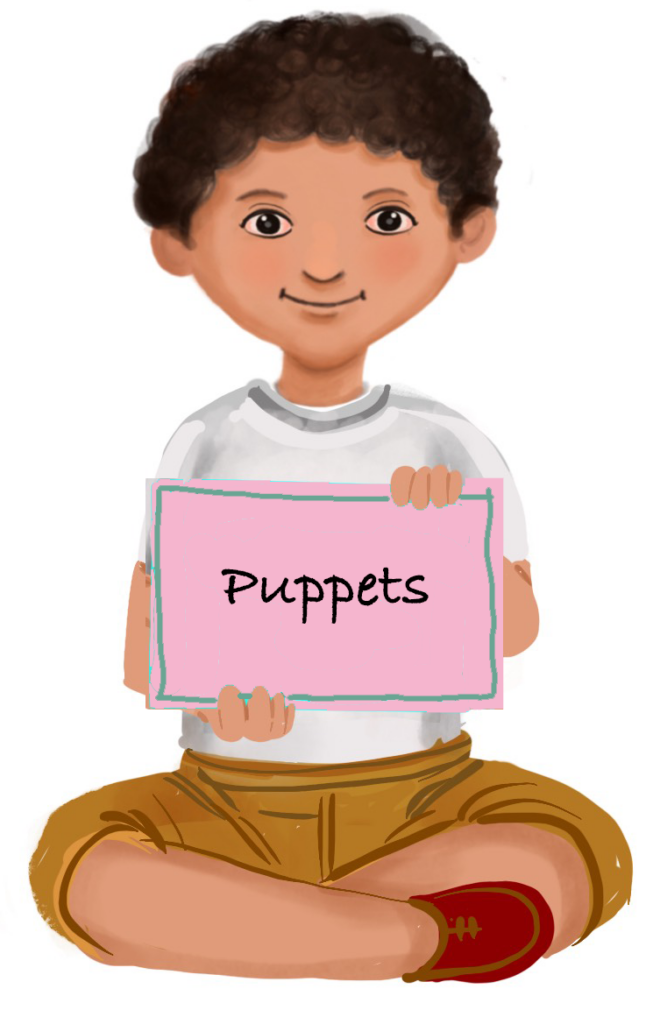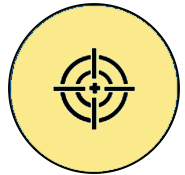
Chart Paper – Face of Man
 Objective
Objective
To guide teachers in creating a puppet of a man’s face for story-telling and other educational purposes.
Estimated time to create the Chart Paper – Face of Man
30 to 45 Minutes
Materials required for creating Chart Paper – Face of Man
- White Chart paper- for the Face, Nose, Ears and paper pipe
- Creepers for hair
- Stapler with pin
- Pencil
- Fevicol
- Scissors
- Marker Pens – Black and Red
Preparation for activity
Keep the materials ready. If you are using hot glue instead of Fevicol, ensure that the hot glue is heated suitably and is ready for use.
Procedure
- First of all, draw and cut out the shapes of the nose and ears.
- Now, start making the face. Take a strip of white chart paper and roll it so that the shorter edges of the strip overlap to form a hollow cylinder. Secure the overlapping ends using a stapler or fevicol. The hollow base for the face is now ready.
- To shape the face into a round form, make three thin cuts along one edge of the cylinder. Overlap the cut sections slightly and fix them one over the other using fevicol. Repeat this step on the opposite edge. This will give a near-round shape to the face.
- Using fevicol, attach the ears on either side and fix the nose in the centre of the face.
- Draw the eyes and eyebrows with a black marker.
- Use a red marker to draw the lips.
- For the hair, cut strips of creepers to the desired length and attach them to the top and sides of the head using fevicol.
- For the moustache, cut two equal-sized pieces of creeper and fix them below the nose.
- For the beard, cut longer pieces of creeper and fix them on the chin and cheeks, using fevicol.
- For the Finger Pipe: Roll a small strip of paper into a tube that fits your forefinger (Index finger). Stick the edge to form the pipe and fix it behind the hollow face using fevicol.
- Allow a few minutes for everything to dry. Your puppet is now ready.
- Insert your forefinger (index finger) into the paper pipe.
- Move your finger up, down and sideways to demonstrate the movement of a man’s head.
- A similar puppet can be made for a woman by following the same steps with suitable features.
Step by Step Pictures to create the puppets
Important Tips
- Black coloured paper can be used for the hair instead of using ‘creepers’ (artificial hair which we wear in drama make-up)
- Wedding cards/ book covers can be good alternatives to drawing sheets.
- To speed up the gluing process, glue drops, glue gun or a stapler can be used instead of fevicol.
- Reference images from drawing books or the internet can be helpful while designing the puppet.
- While creating the puppet, try to replicate the character illustration from the children’s textbook. Once the puppet is ready, refer to it by the character’s name from the textbook. This helps children connect with the content and improves recall.
- The teacher should use the puppet at an appropriate time, perhaps while narrating the story in a funny and humorous way. Intentional mistakes can also be made to encourage children to correct them, making the session more interactive and engaging.
Precautions
Precautions to be taken while manipulating finger puppets:
- Always keep the puppet’s face directed towards the audience.
- The Puppet Master’s focus should remain on the puppet, at all times.
- Only the puppet that is ‘speaking’ should be animated; all other puppets should remain still.
Troubleshooting:
- While making the paper pipe, ensure it matches the exact size of the finger you will be using. This helps to move the puppet properly.
- Use a cutter carefully to make clean, precise holes.
- The holes should match the size of your fingers. If the hole is too large, the puppet won’t stay upright on your finger. If the hole is too small, it will be difficult to insert your finger.
 Notes to the Teacher
Notes to the Teacher
Puppets can be effectively used in the classroom to help children understand and express emotions. They are also valuable tools for teaching rhymes, songs, stories and more.
In addition to enriching learning experiences, using puppets supports the development of motor skills such as hand-eye coordination. They also enhance communication and social skills, improve focus and concentration, and help reinforce concepts and values in an engaging way.
Using the Learning Teaching Material
The teacher can demonstrate a puppet show as an example. Students can then be encouraged to create their own puppets and present a puppet show in the classroom.
Video: How to use Learning Teaching Material
| Source and Attribution of images All images used in the above Assets and Aids are originally created. |
| This digital material has been developed by the Sri Sathya Sai Vidya Vahini Inclusive Education Project, a unit of Sri Sathya Sai Central Trust, Prasanthi Nilayam, as a collaborative offering in the service of our nation. |